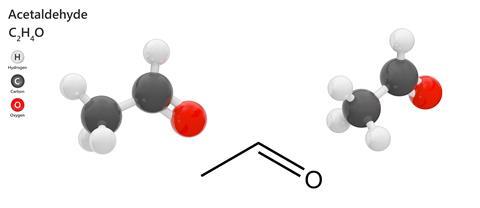Meera Senthilingam
This week, nursing a hangover? Well Brian Clegg explores the compound behing the pain.
Brian Clegg
Organic chemistry, as befitting the chemistry of life, has a number of impressive family groups, from the alkanes to phenyl compounds. Two of the most pervasive are the aldehydes and ketones, both featuring a carbon atom double bonded to oxygen, and only differing in that aldehydes have one hydrogen and one carbon chain attached, while ketones have two carbon chains.
The simplest aldehyde, methanal (also known as a formaldehyde) has a single hydrogen atom in place of the carbon chain, while acetaldehyde (officially called ethanal) has a methyl group – just a carbon with three hydrogen atoms.

Acetaldehyde was one of the earlier organic compounds to be discovered, when the Swedish chemist Carl Wilhelm Scheele detected it in 1774, the same year that he first produced chlorine. A number of other chemists investigated its properties before the German Justus von Liebig settled on the name aldehyde in 1835, which would be changed to acetaldehyde by the 1860s. Von Liebig coined the name from ‘alcohol dehydrogenated’, al-de-hyd, reflecting the close relationship between acetaldehyde and ethanol, the alcohol many of us drink.
Before people realised that methanol was a more effective starting point, the principle industrial use of acetaldehyde was in the production of acetic acid. Even without this, over a million tonnes a year of acetaldehyde is still produced as a reagent for manufacturing polyvinyl acetate (or PVA), in a variant of urea formaldehyde - the resin used in MDF and for adhesives and space-filling insulating foam, and as a starting point for other resins, varnishes and even food preservatives. Acetaldehyde is no shy, retiring wallflower.

In fact, this compound has a reputation for being something of a bruiser, as it is often blamed for giving us hangovers. Ethanol is a poison, and the body has built-in agents to protect us from it. In the liver, ethanol is converted to acetaldehyde by an enzyme called alcohol dehydrogenase, while the acetaldehyde itself is then converted to acetic acid by the equally imaginatively named enzyme, acetaldehyde dehydrogenase. Similarly, if alcohol makes it to the brain, a different enzyme, catalase, undertakes the oxidization job and turns out the acetaldehyde.
This all seems sensible and well-organized, but the problem the body faces is that acetaldehyde is actually significantly more toxic than alcohol, and for some time, acetaldehyde was blamed as the primary cause of hangovers. It seems, though, that this is an over-simplification. One of the problems with pinning down the hangover is that it is a blanket term that takes in a wide range of symptoms and potential causes.
Apart from the impact of the late night that often goes with heavy drinking, one major factor contributing to hangovers is dehydration. Alcohol is a diuretic, increasing urine production and leaving the drinker dry mouthed, nauseated and with a thumping head. What’s more, the enzymes used to turn alcohol into acetaldehyde and then to acetic acid have other important roles in the metabolism. While they are busy rescuing your body from an alcohol attack, they are not contributing enough to their other roles, often resulting in a drop in glucose levels in the brain, producing tiredness, mood swings and lack of concentration. And then most alcoholic drinks also contain other secondary chemicals, like aldehydes and esters, which themselves can have deleterious effects on the body.

Usually those busy enzymes convert acetaldehyde to acetic acid very quickly, but this doesn’t mean that acetaldehyde is incapable of producing unpleasant effects. It may still have some contribution to the impact of hangovers after rapid alcohol consumption which can mean that there is more acetaldehyde in the system than can be broken down by the enzymes in the time available. The result of this poisoning can be severe headaches and vomiting. In fact, this effect is intentionally triggered by the anti-drinking treatment Antabuse. This drug works by blocking the enzyme that breaks down acetaldehyde, and the extreme effects then produced if the patient drinks alcohol are due to intentionally initiated acetaldehyde poisoning.
Some people, particularly those of East-Asian origin, have a mutated version of the gene responsible for producing alcohol dehydrogenase which leads to a variant of the enzyme that works significantly faster than the standard structure. The result is that acetaldehyde builds up more in their system than with someone carrying the more common version of the gene, making the consumption of alcohol less attractive than for the rest of us. Those carrying this gene variant, effectively, have a built-in supply of Antabuse that ensures that they don’t over-indulge.
Because of its association with hangovers, acetaldehyde has a reputation for being an antisocial compound – but to be fair, it is only an intermediary on the way to rendering alcohol harmless. And in industry, it still plays a significant role in the production of resins and varnishes. So perhaps it is time we took off the distorting beer goggles and looked at this simple organic molecule with a little more affection.
Meera Senthilingam
Science writer Brian Clegg there nursing his hangover by explaining the chemistry of acetaldehyde. Next week, we deceive the antidoping authorities.
Simon Cotton
When the testers did detect that, Arnold came up with an even smarter idea, a molecule that had never, ever, been made before; it was to become famous as THG.
Meera Senthilingam
And discover the chemistry enabling this compound to remain undetected by joining Simon Cotton in next week’s Chemistry in its Element. Until then, thank you for listening, I’m Meera Senthilingam.













No comments yet